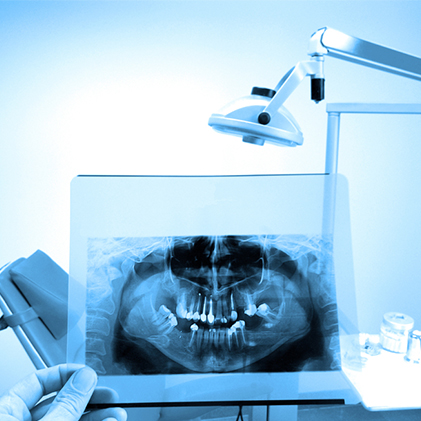IOPA (RVG) & Full Mouth X-ray OPG
Intraoral periapical (IOPA) radiography is a type of dental imaging that involves taking a radiograph (x-ray) of the teeth and surrounding structures within the mouth. IOPA radiographs are used to help diagnose and treat various oral health issues, including tooth decay, gum disease, and dental trauma.
Types of IOPA Radiographs
There are several types of IOPA radiographs that can be taken, depending on the specific needs of the patient and the area of the mouth being examined. Some common types of IOPA radiographs include:
- Periapical radiographs : These radiographs are used to examine the teeth and surrounding bone, including the roots of the teeth.
- Bitewing radiographs : These radiographs are used to examine the teeth in the upper and lower jaw, including the surfaces of the teeth and the bone surrounding them.
- Panoramic radiographs : These radiographs are used to examine the entire mouth, including all of the teeth and surrounding structures.
- Cone beam computed tomography (CBCT) scans : These scans are used to provide detailed, three-dimensional images of the teeth and surrounding structures.

Indications for IOPA Radiographs
IOPA radiographs are commonly used to diagnose and treat various oral health issues, including:
- Tooth decay : IOPA radiographs can help diagnose tooth decay by identifying areas of decay on the teeth.
- Gum disease : IOPA radiographs can help diagnose gum disease by identifying areas of inflammation and bone loss.
- Dental trauma : IOPA radiographs can help diagnose dental trauma by identifying areas of injury or damage to the teeth and surrounding structures.
- Oral cancer : IOPA radiographs can help diagnose oral cancer by identifying abnormal growths or lesions in the mouth.
Benefits of IOPA Radiographs
IOPA radiographs have several benefits, including:
- Improved diagnosis : IOPA radiographs can help improve diagnosis and treatment of oral health issues by providing clear images of the teeth and surrounding structures.
- Reduced treatment time : IOPA radiographs can help reduce treatment time by allowing dentists to diagnose and treat oral health issues more quickly and accurately.
- Reduced risk of complications : IOPA radiographs can help reduce the risk of complications associated with oral health issues by allowing dentists to identify and address potential problems early on.
- Improved patient care : IOPA radiographs can help improve patient care by providing dentists with detailed information about the patient's oral health and allowing them to develop personalized treatment plans.
Full Mouth X-Ray or OPG
A full mouth x-ray, also known as an OPG (Orthopantomogram), is a type of dental radiograph that provides a comprehensive view of the entire mouth. It is a valuable diagnostic tool that helps dentists and orthodontists diagnose and treat various oral health issues.
How is an OPG taken?
An OPG is taken by positioning the patient's head in a special machine that uses a rotating tube to capture a panoramic image of the entire mouth. The machine is designed to take a single, high-quality image that includes all of the teeth, jawbone, and surrounding structures.
What does an OPG show?
An OPG provides a detailed view of the entire mouth, including:
- Teeth : An OPG shows all of the teeth in one image, including their shape, size, and position.
- Jawbone : The OPG shows the jawbone and its relationship to the teeth.
- Sinuses : The OPG shows the sinuses and their proximity to the teeth.
- Roots : The OPG shows the roots of the teeth and any potential problems, such as root resorption or impaction.
- Joints : The OPG shows the temporomandibular joints (TMJs) and any potential problems, such as joint disease or trauma.
What are the benefits of an OPG?
An OPG provides several benefits, including:
- Accurate diagnosis : An OPG helps dentists diagnose various oral health issues, including tooth decay, gum disease, and oral cancer.
- Comprehensive treatment planning : An OPG provides valuable information that helps dentists plan comprehensive treatment for patients with complex oral health issues.
- Reduced radiation exposure : An OPG uses a single exposure to capture a panoramic image, which reduces radiation exposure compared to multiple intraoral x-rays.
When is an OPG used?
An OPG is commonly used in various dental and orthodontic situations, including:
- Orthodontic treatment planning : An OPG helps orthodontists plan treatment for patients with complex orthodontic needs.
- Dental implant placement : An OPG helps dentists determine the best placement for dental implants.
- Wisdom teeth removal : An OPG helps dentists identify potential problems with wisdom teeth, such as impaction or infection.
- Oral cancer screening : An OPG can help detect signs of oral cancer, such as abnormal growths or lesions.